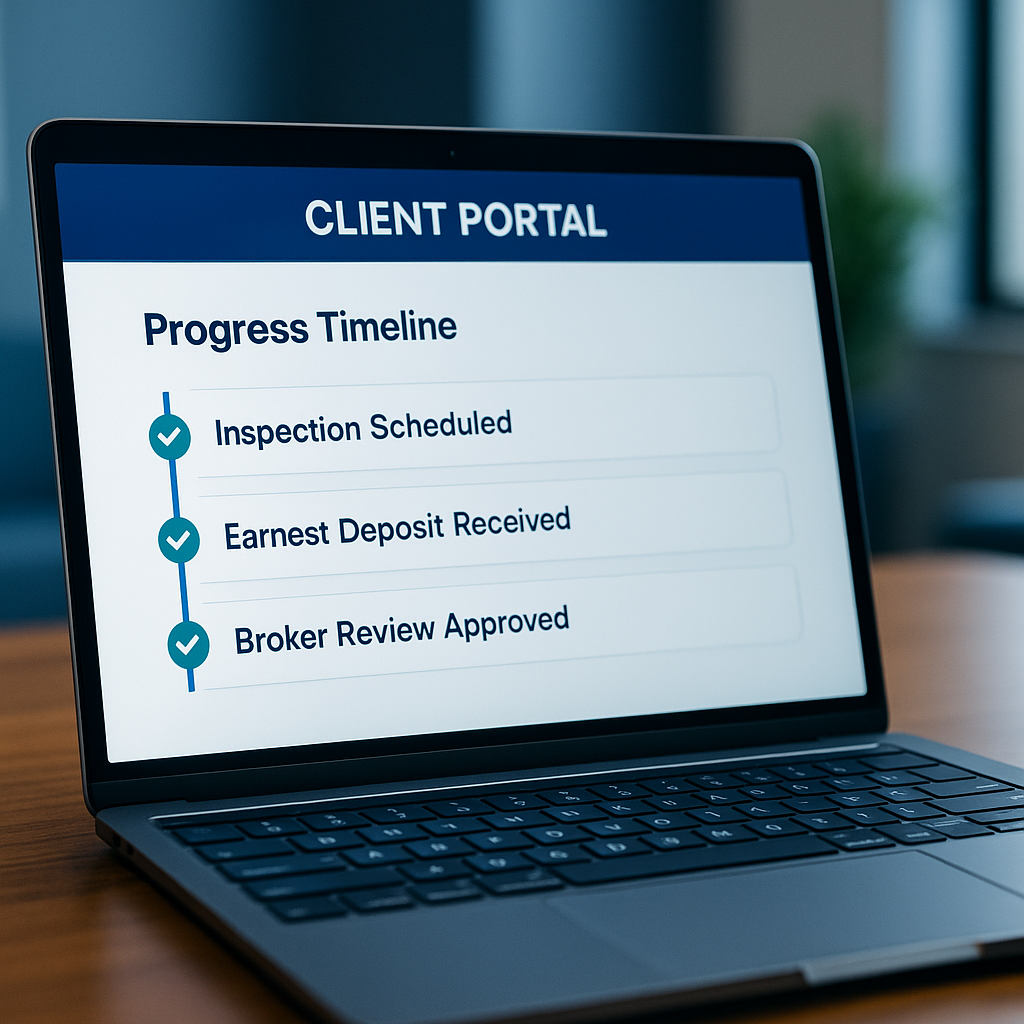Real estate client portals are quickly becoming a must-have for brokerages that want to build trust, provide transparency, and keep clients informed. Real estate is one of the most stressful processes most people go through. Buyers and sellers juggle contracts, inspections, lenders, and moving plans. For them, it’s not just a deal — it’s their life.
And through all that stress, one question comes up over and over again:
“Where are we in the process?”
Traditionally, the answer came through a phone call, a text, or an email. Clients reached out to their agent. The agent reached out to the coordinator. The coordinator interrupted the broker. The cycle repeated, eating hours every week.
I’ve lived this myself. I’ve had weeks where three different clients called me in one evening, not because anything was wrong, but because they felt “in the dark.” I’ve had agents lose credibility with their clients because updates weren’t visible, even though the file was in perfect shape.
That’s why I believe every brokerage needs a client portal. Not just as a nice add-on, but as a core part of your business. Because transparency builds trust — and trust is the most valuable currency in real estate.
Table of Contents
The New Standard: Transparency as an Expectation
Ten years ago, clients were happy to get phone calls with updates. Today, that feels outdated.
Why? Because other industries have set the bar.
- Banking → People expect instant balance checks, push notifications, and digital statements.
- E-commerce → They can track a $40 package in real time, step by step.
- Healthcare → Patients log in to see test results, prescriptions, and secure messages.
When someone can see where their Uber driver is but not where their $700,000 deal stands, something feels wrong.
According to a recent NAR survey, over 60% of buyers and sellers say they want more visibility into their transaction progress. That number will only grow. As Forbes notes, transparency is one of the most important factors in building lasting client trust.
Brokerages that deliver transparency will win client trust and referrals. Those that don’t will look disorganized, even if their back office is solid.

What Clients Actually Want to See
Clients don’t care about every back-office detail. They want clarity on a few key areas:
1. Status Updates
Milestones like:
- “Inspection scheduled”
- “Earnest deposit received”
- “Appraisal complete”
- “Broker review approved”
These small confirmations reassure clients that the deal is moving forward.
2. Documents in One Place
Clients don’t want to search through their inbox for attachments. They want:
- Purchase contract
- Disclosures
- Addenda
- Closing statements
All in one secure location.
3. Next Steps
They need to know:
- What’s waiting on me?
- What’s waiting on the other party?
- When is it due?
Clarity reduces anxiety.
4. Secure Messaging
A portal gives clients one place to communicate, tied to the transaction. No more scattered email threads or lost texts.
5. Contact Directory
When questions do come up, clients need to know who to ask. A good portal shows the escrow officer, lender, coordinator, agent, and broker.
When these needs are met, trust builds naturally.
The “Where’s My File?” Problem
Every broker and coordinator knows the pain:
- Buyer: “Did my earnest money clear?”
- Seller: “When is the inspection?”
- Lender: “Do you have the signed addendum yet?”
- Agent to broker: “Do we have CDA approval?”
I’ve personally lost hours chasing down the same answers across multiple transactions. Multiply that by 20 active deals, and you can see how quickly it drains time and focus.
A portal eliminates these repeat questions. Clients can log in and see:
- ✅ Earnest deposit received
- 📅 Inspection scheduled for Friday
- 📄 Addendum signed and uploaded
No one has to call. No one has to guess.
What Happens Without a Real Estate Client Portal: Real Scenarios
-
Case 1: Lost Referral
A buyer kept asking their agent for updates. The agent was on top of it but had to check in with the TC each time. By the end, the buyer felt the process was “disorganized.” They closed, but they didn’t refer the agent to their family — all because they felt uninformed. -
Case 2: Broker Reputation Risk
A seller accused their brokerage of “dropping the ball” because they didn’t see inspection results until two days later. Everything was handled, but the lack of visibility damaged the relationship. -
Case 3: Wasted Time
One of my coordinators once fielded six calls in a single day from different parties on the same file. Every question was already answered — just not visible.
All three problems are solved with a client portal.
Lessons From Other Industries
Real estate isn’t the first industry to face this problem. Others have solved it:
- Mortgage → Borrowers upload docs, track underwriting, and see conditions in real time.
- Banking → Users check balances and transactions instantly.
- Healthcare → Patients see lab results and visit notes online.
Would you trust a bank without online banking? A doctor without a patient portal?
Soon, clients will feel the same about brokerages without a portal. Research from Harvard Business Review shows companies that invest in customer experience earn higher loyalty and referrals—exactly what a client portal supports.
Why Emails and Shared Folders Fail
Some brokerages try to patch the problem with email, Dropbox, or Google Drive. Here’s why that doesn’t work:
- Email → Gets buried, unsecure, and hard to track.
- Shared folders → Clunky, no context or progress updates.
- Text threads → Informal, fragmented, and not auditable.
These aren’t built for real estate transactions. They frustrate clients and create risk for brokers.

What Makes a Great Real Estate Client Portal
The best portals share common traits:
- Easy Login – Works on phone or desktop without hassle.
- Visual Timeline – Clear milestones: complete, pending, upcoming.
- Document Hub – All contracts, disclosures, and statements in one secure place.
- Role-Based Access – Clients see what they should, not your internal notes.
- Integrated Messaging – Keep conversations tied to the file.
- Audit Trail – Every update logged and time-stamped.
If a portal lacks these, clients won’t use it — and you lose the benefit.
How My Broker Cloud’s Real Estate Client Portal Is Different
I tested other systems: Paperless Pipeline, SkySlope, Brokermint. They all talk about compliance. But their portals?
They feel bolted on. Clients see messy back-office checklists or get pushed back to email for answers. That doesn’t inspire confidence.
My Broker Cloud was built with a different philosophy:
- Client-First View – Clean progress dashboard, not your internal tasks.
- Milestone Tracking – Clients see the big picture at a glance.
- Integrated Document Sharing – Upload once, instantly available to clients.
- Agent & Broker Controls – You decide what’s visible.
- Seamless Experience – Clients log in, check status, and leave reassured.
Other platforms protect the broker’s license. MBC protects both your license and your reputation.
My Perspective: Why I Built Transparency Into MBC
I didn’t set out to build software. I set out to fix problems in my brokerage.
I’ve been the broker answering calls at 9 p.m. from anxious clients. I’ve had to prove a disclosure was sent by digging through emails. I’ve seen agents blamed for being “unresponsive” when the real issue was lack of visibility.
That’s when it clicked: compliance protects your license, but transparency protects your brand.
That’s why My Broker Cloud puts the client portal at the center. It’s not an extra feature. It’s the foundation of trust.
FAQs About Real Estate Client Portals
Do clients really use them?
Yes. If the portal is mobile-friendly and simple, adoption is high.
Does this replace the agent?
No. The portal reduces repetitive questions, freeing agents to focus on advice and negotiation.
What about less tech-savvy clients?
Most already bank online or shop online. For exceptions, agents can still provide email or print summaries.
Is it secure?
Yes. Portals use encrypted logins, SSL, and role-based permissions.
How does it help brokers?
Fewer interruptions, faster closings, stronger reputation.
How does MBC compare?
Unlike others, MBC gives clients a clean, focused view instead of exposing back-office chaos.
What about cost?
The ROI is in time saved, smoother closings, and increased referrals.
Can I use it for recruiting agents?
Yes. Agents want tools that impress clients. Show them the portal in recruiting conversations.
Can it help win listings?
Absolutely. Sellers want confidence. Showing them your portal can set you apart in presentations.
How to Roll Out a Real Estate Client Portal Without Overwhelming Your Team
Switching from phone calls, texts, and email to a client portal doesn’t have to feel like a massive shift. The key is introducing it strategically so your agents adopt it, and your clients embrace it.
1. Start With Internal Training
Before you roll it out to clients, make sure your team is comfortable. Walk your agents and coordinators through the portal as if they were clients. Show them how to log in, where to find documents, and what the client sees. When your staff understands the value, they’ll explain it confidently to clients.
2. Frame It as a Client Benefit, Not Just a Tool
Agents should present the portal as part of their service package. A simple script works:
“You’ll have your own login to our portal, where you can see every step of the process, your documents, and what’s coming next. That way, you’ll never feel in the dark.”
This positions the portal as reassurance, not extra work.
3. Roll Out With Active Transactions
Choose a few transactions where you know the clients will appreciate extra visibility — detail-oriented sellers, first-time buyers, or anyone who’s already asking lots of questions. These clients become your first success stories.
4. Collect Testimonials Early
After closing, ask those clients: “How helpful was the portal for you?” A short quote about peace of mind or time saved becomes powerful marketing material for recruiting and listing presentations.
5. Market It as a Differentiator
Once the team is comfortable, highlight the portal in your brokerage’s marketing. Add it to listing presentations, recruiting packets, and your website. Position it not as “software,” but as proof your brokerage values transparency and client care.
The Future of Real Estate Client Portals: From Visibility to Intelligence
Client portals today give buyers and sellers a window into their transaction — documents, milestones, next steps. But that’s just the beginning. The next generation of portals won’t stop at visibility. They’ll actively provide insights, guidance, and efficiency boosts for both clients and agents.
Imagine a portal that doesn’t just show an appraisal is scheduled, but predicts when it will complete based on local averages, then alerts the client and agent if there’s likely to be a delay. Or a system that reviews uploaded documents in real time and flags missing initials before they ever reach the broker. That’s where AI comes in: not replacing people, but acting as a second set of eyes to prevent errors and eliminate surprises.
These advancements aren’t a distant dream. Other industries have already proven the model. Banking apps highlight unusual spending patterns. Healthcare portals flag critical lab results before a doctor even calls. Real estate is next.
And just as online banking moved from “nice to have” to “expected baseline,” the same will happen here. Clients will no longer ask, “Does your brokerage have a portal?” They’ll assume it does — and if it doesn’t, they’ll wonder what else you’re behind on.
For brokerages, this evolution isn’t optional. Portals will become the digital handshake between you and your clients: the way you prove competence, build trust, and stay competitive in a market that demands both speed and clarity.
Final Thoughts
Your clients don’t just want a transaction. They want confidence. They want to feel their broker is competent, trustworthy, and transparent.
A client portal isn’t optional anymore. It’s the bridge between your back office and your client’s peace of mind.
At My Broker Cloud, we built ours to protect both sides: compliance for the broker, transparency for the client. Because a deal that’s legally sound but emotionally stressful isn’t a win.

